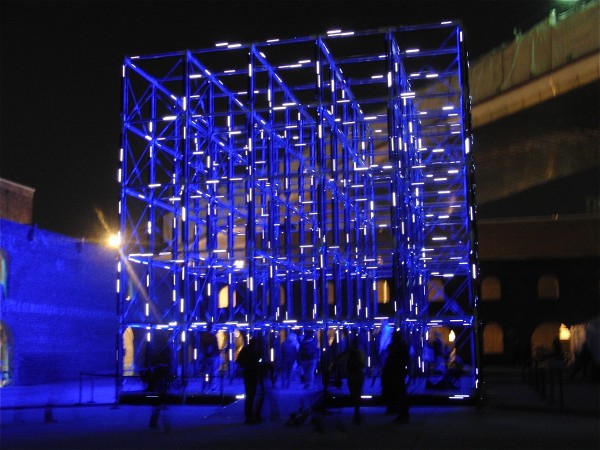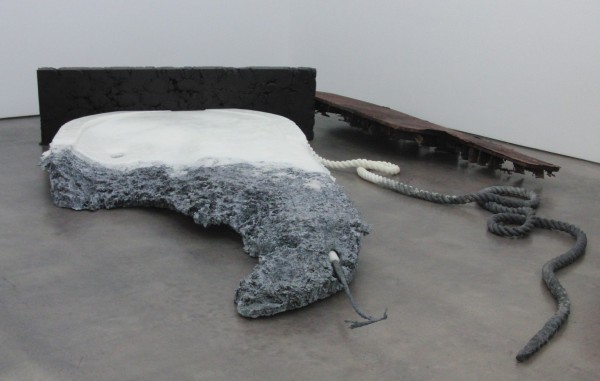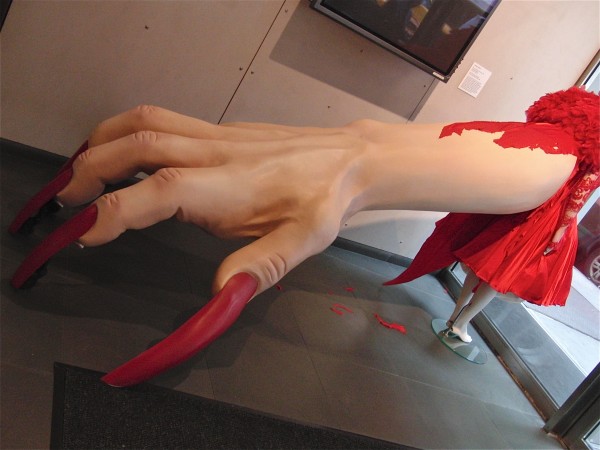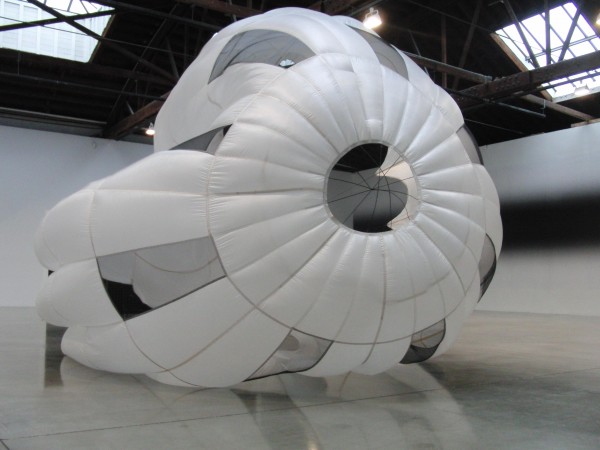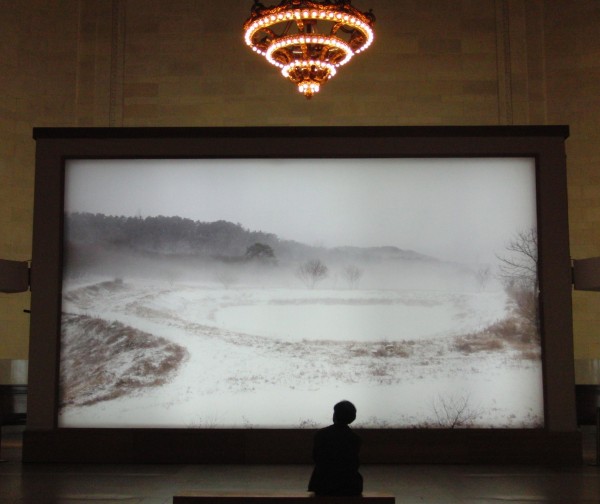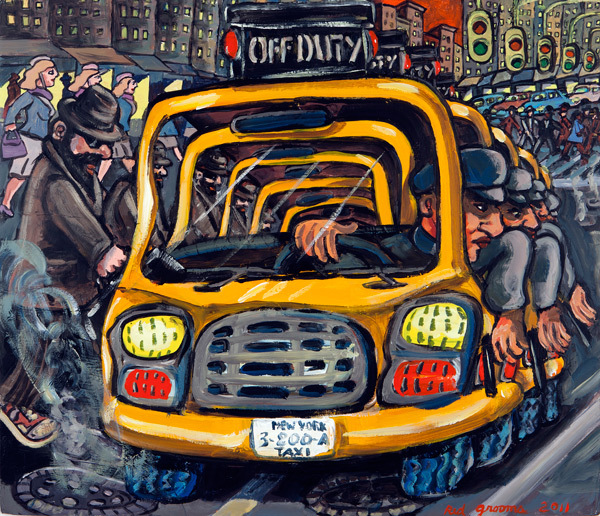
Red Grooms, “Spy Cab,” acrylic on paper, 2011 (courtesy of Marlborough Gallery)
“RED GROOMS, NEW YORK: 1976-2011”
Marlborough Gallery
40 West 57th St.
Through October 22, free, 10:00 am – 6:00 pm
212-541-4900
www.marlboroughgallery.com
In the playful noir short story that opens the catalog of his latest exhibition at the Marlborough Gallery, Red Grooms’s alter ego, Gunslinger, says, “Ya see, I wanted to show the public how low it gets sometimes, down under the belly of the beast.” For more than fifty years, Grooms has been revealing the belly of the beast that is New York, but it turns out that Grooms’s world is filled with colorful caricatures living it up in the maelstrom he refers to as “the city that never snores.” In “Red Grooms, New York: 1976-2011,” Grooms, who was born and raised in Nashville and has lived in New York City since 1957, collects some of his finest work of the last thirty-five years, including paintings, mixed-media constructions, sculpto-pictoramas, and such walk-in installations as “The Bus” and “42nd Street — Porno Bookstore.” Grooms has an innate sense of life in the Big Apple, capturing the essence that lies at the heart of the city in such pieces as “The Funny Place,” “Give My Regards to Broadway,” “Small Hot Dog Vendor,” and “Tattoo Parlor.” We recently spoke with Grooms, a tall, engaging, and quite forthcoming fellow, at the exhibit’s opening, where he was surrounded by admiring fans who could not wipe the huge smiles off their faces, and later by phone.
twi-ny: There’s a timeless quality to your work, in which you display a unique view of New York. The city has gone through some major changes during the period covered in this exhibition. How do you see the New York of 1976, or even the 1950s, as different from today?
Red Grooms: I think it’s great right now. It just seems very vibrant to me. It seems like there are twice as many people as there used to be. I’m down here below Canal St., almost in Chinatown and near the courts. We’re getting a tremendous amount of tourists —Chinatown, Little Italy, and then going on downtown, down Broadway. That vibrancy and energy, I enjoy it; it’s fun. So I would hope I get some of that now with what I’m doing.
I have a few late works in the show — “Count Tribecula” is one of them — to get the funny quality of the TriBeCa area. I’ve always done a lot on Chinatown. I’ve been in the same studio on Walker St. for forty-two years, so I have seen a bunch of different things. It used to be the hardware center; that actually influenced my work a lot. It took me two minutes to go out and get whatever I needed. There’s still some plastic stores. In the ’70s, plastic was kind of a fashionable medium for a while, and I indulged in it myself. Those different media influenced the work. Right here there’s always been a fabric center as well.
twi-ny: Speaking of different media, in several works from 2010, you have incorporated digital imagery. What made you start doing that?
Red Grooms: I consider myself absolutely not a photographer, and so I used the throwaway cameras, and I’ve literally taken hundreds, if not even thousands, of pictures. About two years ago, I looked through the pictures of ten or so years ago, and they had sort of settled in, so some of them looked kind of special just because it was a particular moment. I started to make collages with them.
This one scene called “Lunchtime on Broadway,” which is panoramic, I took a whole bunch of pictures and glued them together — you know, cut and paste — and made a fairly large composite, and I used that to make that dimensional work, and in doing that, I discovered that if you cut out a figure, it leaves a hole in putting it on a white piece of paper; it got a very strong jump to it between the silhouette and the photographic background. So in that process, I made a whole bunch of four-by-six cards, cut out elements that I wanted to, and then I water-colored in the same thing that was in there. In doing that was when I enlarged them more and did the works you see in the show now.

Red Grooms enjoys the opening of his latest exhibit at the Marlborough Gallery on 57th St. (photo by twi-ny/mdr)
twi-ny: With regard to technology, you don’t have a cell phone or e-mail, and you don’t use a computer, is that right?
Red Grooms: I’m pathetically old school in that way. My wife is capable. You know, it’s really hard to work with people without it. It’s very difficult. I think it will be impossible soon.
twi-ny: Another of the places that you have always captured is Times Square and Broadway. What do you think of the new Times Square?
Red Grooms: When I did the early works from ’76, ’77, I did do research up there, and it was funny because after “Ruckus Manhattan” opened, it was very popular and got a lot of press, so they called me in, some of the people who were trying to clean up Times Square at the time, to see if I had any ideas. I had this weird duality about it. I actually wanted to do something, but in the end, I couldn’t really think of anything. Nothing panned out.
twi-ny: It’s probably best that way.
Red Grooms: So I was there when they were starting to do it. They had a lot of trouble, actually, a lot of starting and stopping on that project before it really got going and became what it is now. We don’t have those places like “Porno Bookstore” anymore. They were so prevalent at that time.
twi-ny: Well, it’s great to now have it on 57th St. at the Marlborough.
Red Grooms: That was a little daring. It hadn’t been up for thirty-four years. It ran well when “Ruckus” showed at the Marlborough in ’77; we didn’t really get any complaints. But in ’82 I had a show with the “Ruckus” stuff on 54th St. and Sixth Ave., and when we were unpacking the stuff, the superintendent of the building took a look at the porno store and said he was going to close the whole show down if we tried to put that up.
twi-ny: In the catalog, you open with a short noir story in which you work many of the pieces’ names into it. Is this writing something you’re exploring more?
Red Grooms: I wrote it together with my wife, Lysiane Luong, and it was a lot of fun. In fact, it was so much fun that we were going to jump right in to an actual full-length detective story, but we didn’t get very far. You’re one of the first persons right now talking about it. I very much liked doing it.
twi-ny: You’ve used the word “fun” several times, and that’s a good way to describe what people experience when they see your work. At the opening, everyone was laughing and smiling. What kind of satisfaction does that bring you?
Red Grooms: It’s great, it’s exciting. You know, I’m quite isolated when I do it. . . . But my dreams of monetary success never panned out.
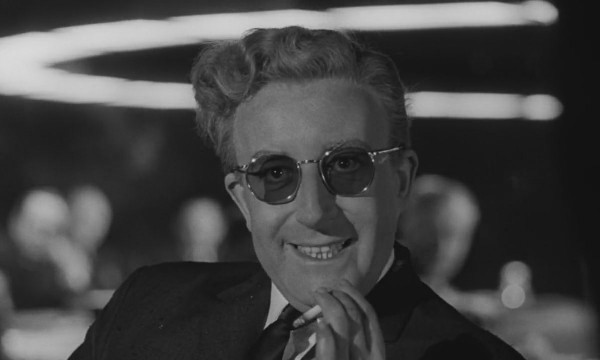
 Screening at 92YTribeca as part of the third annual Doomsday Film Festival — which promises “Deserted streets! Blood-red skies! Total social breakdown!” — Stanley Kubrick’s Dr. Strangelove is one of the grandest satires ever made, the blackest of black comedies. With the threat of nuclear annihilation looming over the United States and the Soviet Union, General Jack D. Ripper (Sterling Hayden) has a meltdown, becoming obsessed with protecting the country’s “precious bodily fluids” and threatening to launch the bombs. While President Merkin Muffley (Peter Sellers) tries to make nice with the Soviets, General Buck Turgidson (George C. Scott) gets caught up in all the military excitement, Colonel Bat Guano (Keenan Wynn) defends the Coca-Cola company, Group Captain Lionel Mandrake (Sellers) can’t get anyone to listen to him, and Major T. J. “King” Kong (Slim Pickens) prepares for the ride of his life. Based on Peter George’s novel Red Alert and written by George, Kubrick, and Terry Southern, Dr. Strangelove or: How I Learned to Stop Worrying and Love the Bomb is hysterically funny and wickedly prescient, an absolute hoot from start to finish, featuring razor-sharp dialogue, inspired slapstick, and just enough truth to scare the hell out of you. (Be sure to watch for Peter Bull not being able to stop laughing as Sellers goes crazy in a wheelchair at the end.) The screening will be followed by a “Doomsday on the Brain” panel discussion with Joseph Le Doux, Dr. Mark Siegel, Lee Quinby, Keith Uhlich, and Mark Asch, moderated by Paul W. Morris from, of course, BOMB magazine. The Doomsday Film Festival also includes Steve De Jarnatt’s 1988 WWIII flick Miracle Mile, followed by a Q&A with star Anthony Edwards and the director; Don McKellar’s 1999 Y2K nightmare Last Night; Joseph Sargent’s classic Colossus: The Forbin Project, followed by “The Singularity Is Nigh,” a panel discussion with Maggie Jackson, Joshua Rothkopf, Jason Zinoman, Chris Bregler, and Roger Schank, moderated by Michael Byrne; Tobe Hooper’s 1985 exploitation fave Lifeforce, preceded by complimentary sexy alien zombie makeup; a collection of short films; and schlockmeister Larry Cohen’s 1976 cop drama God Told Me To, followed by a Skype Q&A with Cohen. If the end of the world is coming, this is a fine way to say goodbye.
Screening at 92YTribeca as part of the third annual Doomsday Film Festival — which promises “Deserted streets! Blood-red skies! Total social breakdown!” — Stanley Kubrick’s Dr. Strangelove is one of the grandest satires ever made, the blackest of black comedies. With the threat of nuclear annihilation looming over the United States and the Soviet Union, General Jack D. Ripper (Sterling Hayden) has a meltdown, becoming obsessed with protecting the country’s “precious bodily fluids” and threatening to launch the bombs. While President Merkin Muffley (Peter Sellers) tries to make nice with the Soviets, General Buck Turgidson (George C. Scott) gets caught up in all the military excitement, Colonel Bat Guano (Keenan Wynn) defends the Coca-Cola company, Group Captain Lionel Mandrake (Sellers) can’t get anyone to listen to him, and Major T. J. “King” Kong (Slim Pickens) prepares for the ride of his life. Based on Peter George’s novel Red Alert and written by George, Kubrick, and Terry Southern, Dr. Strangelove or: How I Learned to Stop Worrying and Love the Bomb is hysterically funny and wickedly prescient, an absolute hoot from start to finish, featuring razor-sharp dialogue, inspired slapstick, and just enough truth to scare the hell out of you. (Be sure to watch for Peter Bull not being able to stop laughing as Sellers goes crazy in a wheelchair at the end.) The screening will be followed by a “Doomsday on the Brain” panel discussion with Joseph Le Doux, Dr. Mark Siegel, Lee Quinby, Keith Uhlich, and Mark Asch, moderated by Paul W. Morris from, of course, BOMB magazine. The Doomsday Film Festival also includes Steve De Jarnatt’s 1988 WWIII flick Miracle Mile, followed by a Q&A with star Anthony Edwards and the director; Don McKellar’s 1999 Y2K nightmare Last Night; Joseph Sargent’s classic Colossus: The Forbin Project, followed by “The Singularity Is Nigh,” a panel discussion with Maggie Jackson, Joshua Rothkopf, Jason Zinoman, Chris Bregler, and Roger Schank, moderated by Michael Byrne; Tobe Hooper’s 1985 exploitation fave Lifeforce, preceded by complimentary sexy alien zombie makeup; a collection of short films; and schlockmeister Larry Cohen’s 1976 cop drama God Told Me To, followed by a Skype Q&A with Cohen. If the end of the world is coming, this is a fine way to say goodbye.